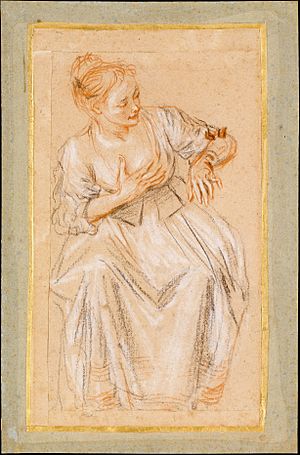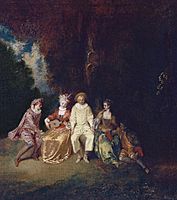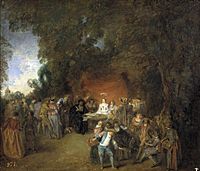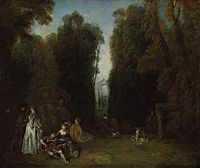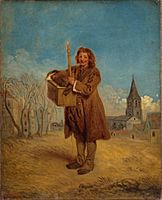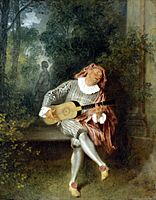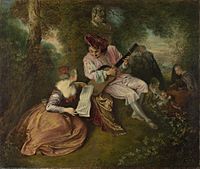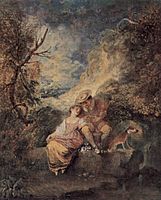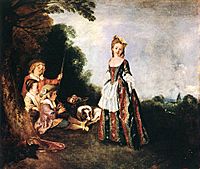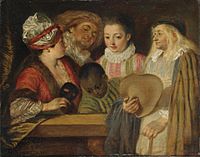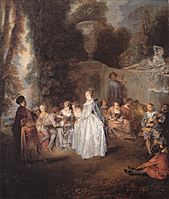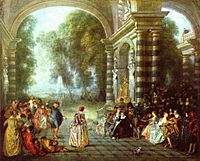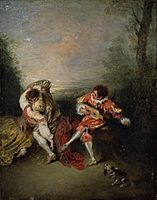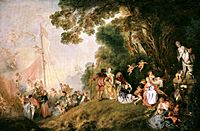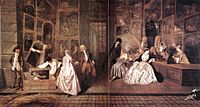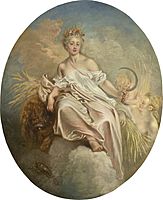Antoine Watteau facts for kids
Quick facts for kids
Antoine Watteau
|
|
|---|---|
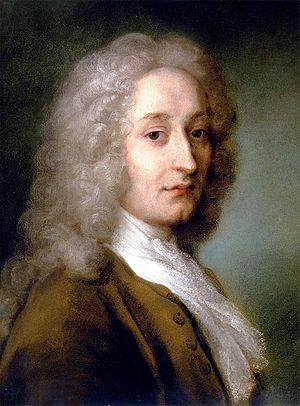
Rosalba Carriera, Portrait of Antoine Watteau, c. 1721, showing the artist in the last year of his life. Musei Civici, Treviso
|
|
| Born |
Jean-Antoine Watteau
baptised October 10, 1684 |
| Died | July 18, 1721 (aged 36) Nogent-sur-Marne, France
|
| Nationality | French |
| Education |
|
| Known for | Painting and drawing |
|
Notable work
|
Embarkation for Cythera, 1717–1718 L'Enseigne de Gersaint, 1720–1721 |
| Movement | Rococo |
| Patron(s) |
|
Jean-Antoine Watteau (baptised October 10, 1684 – died July 18, 1721) was a famous French painter and artist. Even though his career was short, he brought back interest in using bright colors and showing movement in art. He helped change the older Baroque art style into the newer, softer, and more natural Rococo style.
Watteau is known for creating a new type of painting called fêtes galantes. These paintings show charming outdoor scenes, often with people dressed up, enjoying themselves in beautiful, dream-like settings. Many of his well-known paintings were inspired by Italian comedy shows (like commedia dell'arte) and ballet.
Early Life and Training
Jean-Antoine Watteau was born in October 1684 in Valenciennes, a town that is now part of France. He was the second of four sons. His family was quite well-off, but his father was known for being a bit rough.
Antoine showed an early interest in painting. He might have learned from a local painter named Jacques-Albert Gérin. His first artworks often showed street performers selling fake medicines in Valenciennes.
In 1702, Watteau moved to Paris. For a while, he painted backgrounds for plays. Later, he worked in a workshop where he copied popular paintings from the Netherlands. During this time, he developed his special way of sketching quickly.
His drawings caught the eye of the painter Claude Gillot. By 1705, Watteau was working as Gillot's assistant. Gillot's art was a reaction against the serious official art of King Louis XIV. In Gillot's studio, Watteau learned about the characters from commedia dell'arte, which became a favorite subject for him.
After a disagreement with Gillot, Watteau moved to the workshop of Claude Audran III. Audran was an interior decorator and took care of the Palais du Luxembourg. From Audran, Watteau learned a lot about decorative art and design. At the palace, Watteau saw a wonderful series of paintings by Peter Paul Rubens that were made for Queen Marie de' Medici. Rubens became a major influence on Watteau. He also studied the works of Venetian masters in the collection of his friend and supporter, the banker Pierre Crozat.
During this time, Watteau painted The Departing Regiment. This was one of his first paintings in his own unique style, showing Rubens' influence. He showed it to Audran, who didn't think much of it. Watteau then decided to leave Audran and returned to his hometown, Valenciennes. There, he painted several small camp scenes, like Camp-Fire.
Later Career
In 1709, Watteau tried to win the Prix de Rome from the Academy to study in Rome. He only won second prize. In 1712, he tried again. A painter named Charles de La Fosse convinced him that he didn't need to go to Rome to learn more. Thanks to Fosse, Watteau became an associate member of the Academy in 1712 and a full member in 1717. It took him five years to finish the special painting needed for full membership, but it was one of his best: Pilgrimage to Cythera, also known as Embarkation for Cythera.
Watteau then lived with the art collector Pierre Crozat. Crozat had a huge collection of about 400 paintings and 19,000 drawings by famous artists. This allowed Watteau to spend even more time studying the works of Rubens and the Venetian masters.
Watteau didn't have many rich noble supporters. His buyers were mostly middle-class people like bankers and art dealers. Some of his most famous paintings, besides the two versions of the Pilgrimage to Cythera, include Pierrot (also called "Gilles"), Fêtes venitiennes, Love in the Italian Theater, Love in the French Theater, and Mezzetin. His famous painting Pierrot shows an actor in a white costume standing alone, looking forward with a mysterious look.
Watteau's last great painting was the Shop-sign of Gersaint. This painting shows an art gallery in Paris. Watteau painted it quickly, in just eight mornings, to "warm up his fingers." It was a sign for the shop of the art dealer Edme François Gersaint. This painting is often seen as a reflection on art and what is real.
Watteau's friends worried about him because he didn't seem to care about his future or money. He had been sick and weak since he was a child. In 1720, he went to London, England, to see Dr. Richard Mead, a famous doctor who admired Watteau's art. However, London's damp and smoky air didn't help him. Watteau returned to France and spent his last few months with his supporter, Abbé Haranger. He died in 1721, possibly from a throat infection related to tuberculosis, at only 36 years old. The Abbé said that Watteau was barely conscious in his last days, holding a paintbrush and painting imaginary pictures in the air.
His nephew, Louis Joseph Watteau, and grand-nephew, François-Louis-Joseph Watteau, also became painters.
Critical Assessment and Legacy
During his lifetime, Watteau was not widely known outside a small group of fans. He was rarely mentioned in art reviews, and when he was, it was often with criticism. However, some experts say Watteau created the idea of an artist who is true only to themselves. While other artists of his time focused on lighthearted romance, Watteau's art often showed a touch of sympathy, longing, and sadness about how quickly love and happiness can fade.
Watteau was a very busy artist when it came to drawing. His drawings, often made using a special technique called trois crayons (three chalks), were highly valued. In the 1720s and 1730s, Jean de Jullienne published many prints of Watteau's drawings and paintings. This helped spread Watteau's influence across Europe and into decorative arts.
Watteau's impact on art was huge, affecting not only painting but also decorative art, costume, film, poetry, and music. The Watteau dress, a long, loose dress with pleats, is named after him because similar dresses appear in his paintings. Some people even see the beginnings of Impressionism in how he painted landscapes and the atmosphere around his figures.
His influence was perhaps stronger in England than in France, with artists like J. M. W. Turner admiring his work. Interest in Watteau's art grew again in England during the British Regency period.
In 1984, Watteau societies were started in Paris and London to celebrate his 300th birthday. A big exhibition was held in Paris, Washington, and Berlin. Since 2000, a Watteau center has been created in Valenciennes. Experts continue to study and list all of Watteau's paintings and drawings.
Gallery
-
Marriage Contract and Country Dancing, c. 1711, Prado Museum, Madrid.
-
La Perspective (View through the Trees in the Park of Pierre Crozat), c. 1715, Museum of Fine Arts, Boston
-
Savoyard with a Marmot, c. 1716, Hermitage Museum, St. Petersburg
-
Mezzetino, c. 1717–1720, Metropolitan Museum of Art, New York
-
Pierrot, c. 1718–1719, Louvre, Paris
-
The Love Song, c. 1717, National Gallery, London
-
The Robber of the Sparrow's Nest, c. 1712, National Galleries of Scotland, Edinburgh
-
Actors of the Comédie-Française, between 1711–1718, Hermitage Museum, Saint Petersburg
-
Les Plaisirs du Bal, c. 1717, Dulwich Picture Gallery, London
-
La Surprise, c. 1718, Getty Center, Los Angeles
-
The Italian Comedians, c. 1719–1721, National Gallery of Art, Washington, D.C.
See also
 In Spanish: Antoine Watteau para niños
In Spanish: Antoine Watteau para niños



